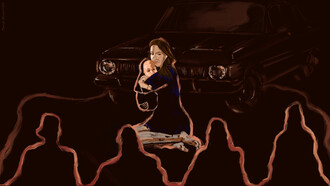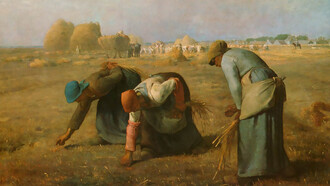In previous articles, I’ve discussed the concept of history-from-below, which is a research methodology that examines historical events, moments, or subjects through the perspectives of individuals that have traditionally been excluded from historical narratives. The popularization of history-from-below in the mid-20th century was largely a response to the traditional inclination of historians to approach their research through the lives of “great men” (mostly political and military leaders) and great events (mostly concerning politics and war). This approach, also referred to as social history, was championed by the Annales School of the mid-20th century, and particularly through the work of Lucien Febvre, Fernand Braudel (discussed at length in this article on the history of the Mediterranean), and Emmanuel Le Roy Ladurie.
Today, Malte Fuhrmann and Ilham Khuri-Makdisi, both historians of the Ottoman Empire, have presented such histories-from-below through the lenses of subjects on the periphery of much Ottoman historiography. This article will discuss two texts of theirs that look at the communication of fringe subjects of the Ottoman Empire from inside Ottoman lands and abroad.
In his chapter '“I would rather be in the Orient’, European Lower Class Immigrants into the Ottoman Lands,” Fuhrmann presents four case studies of lower-class Europeans in the late 19th century who mediated their European “citizenship” with residency in the Ottoman Empire. I put “citizenship” here in quotations because, at the time, it did not mean the same thing to 19th-century Europeans as it does to us today. While the notion of “citizenship” can be traced back to ancient Greece, the term implies the right of “citizens” to participate in the governance of their nation. The monarchies of 19th-century Europe, however, rendered individuals as “subjects” of the state with limited institutional ability to affect political change. Further, it’s debatable to what extent a typical subject of the Ottoman Empire would have identified themselves with the “Ottoman-ness” of the state, or if they would have felt more allegiance to their religious community, familial or tribal ties, or ancestral origins.
In the case of individuals who were born elsewhere in Europe and who later immigrated to the Ottoman Empire, Fuhrmann explores this very idea of contested identity. By identifying three different conceptions of “home” – which could either be cherry-picked by an individual or otherwise thrust upon them – he shows how these people were able to benefit from both their allegiance to their European states-of-origin as well as their residency in the Ottoman Empire.
Immigration to the Ottoman Empire from Europe (particularly from Italy, France, and Germany) was driven by several factors. Large-scale development projects in the Ottoman Empire were creating work opportunities across the region, which was attractive for rural residents who were hard-pressed by the economic stagnation of some European states. Further, European “citizens” living in the Ottoman Empire were often exempted from many taxes and sometimes also judicial punishment. However, the individuals in Fuhrmann’s study often appealed to the bureaucracies of their European countries-of-origin for various reasons. Robert Weiss, for example, was born in Germany but moved to Salonica (present-day Thessaloniki) for work; he later leveraged his German “citizenship” to leave Salonica and return to Germany after becoming increasingly suspicious and paranoid of the Ottoman city’s sizeable Jewish community. Others, such as Anna Forneris and Wilfried Blumberg, eventually returned to Europe after extended sojourns in the Ottoman Empire but failed to reintegrate into European life; Blumberg later returned to the Ottoman Empire out of homesickness.
Khuri-Makdisi also looks at the political power of migration – but more so the migration of ideas rather than of individuals – in her “the Nahda, the Press, and the Construction and Dissemination of a Radical Worldview.” In this text, she traces the evolving rhetoric of socialism and anarchism in the periodicals al-Muqlataf and al-Hilal from the late 19th to the early 20th century. These publications operated out of Beirut, Cairo, and Alexandria, and spread avant-garde ideas during a period referred to as “al-Nahda,” or the “Arab Awakening,” in which political and intellectual thought flourished from several cosmopolitan centres of the Middle East and North Africa. By demonstrating how these publications gradually became more leftist and favorable towards so-called “radical worldviews,” Khuri-Makdisi draws parallels between their evolving sociopolitical outlook and that of the Syrian diaspora outside of the Levant. She writes particularly of the case of Syrian individuals in Brazil, who would have been on the periphery of these communications. She argues that, despite low literacy rates in the Ottoman Empire, the two periodicals reached large audiences through public readings and word-of-mouth, which contributed to a network of exchange of socialist and anarchist ideas whose emergence paralleled that of the nahda, a period of cultural “awakening” across the Arab world.
Khuri-Makdisi centres her study on the two publications partly due to their relative importance in the Syrian community, but also, she writes, because they exemplified the network of production of both ideas and publications in turn-of-the-century Egypt and Syria. Fuhrmann, on the other hand, bases his research primarily on Ottoman and European court and church records, which provide the necessary contextual data to reconstruct the trajectories of his extraordinary case studies. Both authors faced the historiographic challenge of writing histories-from-below; by choosing to focus on ordinary historical actors, they had to rely on sparse textual evidence to frame their positions. There is also the ever-present challenge of survivor bias, that any textual evidence that survives from this period could (and should) be considered extraordinary by the very nature of its survival. However, by focusing on these more intimate documents, Fuhrmann is able to appreciate his subjects’ positions both physically and temporally. Unlike Khuri-Makdisi, who illustrates change over time, Fuhrmann provides a snapshot of four lives caught in the middle of two competing identities. But Khuri-Makdisi’s material also has an advantage in that it allows her to situate her case study in a global framework - one that allows the mapping of trends and evolving sociopolitical outlooks across four continents and over half a century.
While Fuhrmann’s text explicitly addresses the frontier between Orient and Occident, East and West, Khuri-Makdisi is concerned mainly with communications throughout the Syrian diaspora. Her text could also be seen as mediating the “old world” of the Levant with the “new world” of Brazil and the Americas, as radical ideas are spread from the Middle East to diasporic communities abroad.
While Khuri-Makdisi emphasizes communication and network-building, she largely passes over the importance of the literate figures who would have read these publications to their largely illiterate communities. This would have been a common occurrence in the Ottoman Empire, throughout the Levant, and across Europe as one copy of a pamphlet would be read aloud in a coffeeshop, private home, classroom, or other site where people congregate, as both a means of engaging with the intellectual debates flourishing at the time and as an integral part of socialization. The individuals tasked with reading the texts would essentially take on the role of gatekeeper for their communities’ engagement with provocative literature and would have had control over which information was read aloud and which got censored. In this context, the case studies present individuals who act as their own mediators, leveraging political or social connections when convenient.
Fuhrmann and Khuri-Makdisi both present examples of histories-from-below that appear to have also been influenced by microhistorical studies, or case studies of very specific, limited historical snapshots. Taking this a step further, however, both texts examine their case studies in a global – or at least transnational – approach. Both authors also touch on the issue of literacy, which would have made all the difference to both groups of individuals. In Fuhrmann’s case studies, these four individuals were better able to leverage their position through written appeals to their state-of-origin, state-of-residence, or co-nationals. For Khuri-Makdisi, the writers and readers of al-Muqlataf and al-Hilal built a transcontinental network of exchange to spread ideas of socialism and anarchism that aligned with the radical phenomenon of liberal Arab nationalism. Ultimately, both texts expand our understanding of the centre-periphery relationship in Ottoman studies by illustrating that this rapport is often managed by the actors on the periphery, who may not perfectly fit the identity of “Ottoman subject.”
References
1 Fuhrmann, Malte. “‘I would rather be in the Orient.’ European Lower Class Immigrants into the Ottoman Lands” in Ulrike Freitag, Malte Fuhrmann, Nora Lafi, Florian Riedler (eds.) The City in the Ottoman Empire: Migration and the Making of Urban Modernity. London: Routledge, 2011. 228-241.
2 Khuri-Makdisi, Ilham. “The Nahda, the Press, and the Construction and Dissemination of a Radical Worldview” in The Eastern Mediterranean and the Making of Global Radicalism, 1860-1914. Los Angeles: University of California Press, 2010. 35-59.















